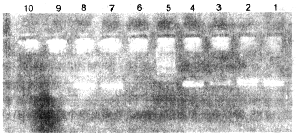 |
关键词:
【摘要 】 目的 探讨肾综合征出血热患者病毒血症在体内消长过程以及与肾脏损伤关系。方法 应用套式逆转录聚合酶链反应对60例肾综合征出血热患者的165份血清、85份外周血单个核细胞(PBMC)和79份尿沉渣细胞标本中汉坦病毒RNA进行检测。结果 发病早期(1~7天)血清、PBMC和尿沉渣细胞中病毒RNA的检出率分别为91.3%、100%和100%。病程8~12天时分别为43.9%、76.2%和81.0%。在病程13~22天分别降至26.3%、31.8%及61.0%。尿沉渣细胞中病毒RNA的检出率与肾脏损伤成正比。结论 在肾综合征出血热发病过程中,病毒血症为一急性过程。PBMC携带病毒时间较血中长4~5天,是向血中及靶器官播散病毒的重要途径。肾脏为出血热病毒早期原发性损伤的靶器官。病毒是导致肾综合征出血热病情轻重的重要因素之一。
Detection of hantavirus RNA in blood and urine in hemorrhagic fever with renal syndrome by polymerase chain reaction Yue Jinsheng* , Zhang Fan, Fan Wanhu, et al. * Department of Infectious Disease, The First Cinical Medical College of Xi'an Medical University, Xi'an 710061
【 Abstract 】 Objective To study the growth and decline process of virusemia and its relationship with kidney damage. Methods We detected Hantavirus (HV) RNA in 165 serum samples, 85 peripheral blood mononuclear cells (PBMC) samples and 79 urinary sediment samples of 60 cases of hemorrhagic fever with renal syndrome (HFRS) by nested reverse transcription polymerase chain reaction (nested RT-PCR). Results The positive rates of HV RNA in serum, PBMC and urinary sediment were 56.4%, 57.6% and 73.4% respectively. In early stage (1st ~ 7th days) of HFRS, the positive rates were 91.3%, 100% and 100% respectively, but the rate in serum decreased to 43.9% during 8th ~ 12th day and that in PBMC decreased remarkably to 31.8% during 13th ~ 22th day. HV RNA positive rate in the cells in the urinary sediment was higher and it remained positive longer than that in serum and mononuclear cells in the same stage. HV RNA positive rate in urine and blood of serious patients in late stage ( ≥ 13th day) was remarkably higher than that of moderate and mild patients. The difference between serious and moderate patients was great (in serum P<0.05, in PBMC P<0.05 and in urinary sediments P<0.01). The difference between serious and mild patients was also great (in serum P<0.001, in PBMC P<0.05 and in urinary sediment P<0.05). HV RNA positive rate in urinary sediment has positive correlation with kidney damage. Conclusion In the development of HFRS virusemia is an acute process, viruses remain in mononuclear cells 4 ~ 5 days longer than in serum, so mononuclear cells are the main pathway to spread viruses into blood and target organ. Kidney is the primary target organ sustaining the damage by HV in early stage. Virus is one of the most important factors which determine the severity of kidney syndrome in all stages of HFRS.
【 Key words 】 Hemorrhagic fever with renal syndrome Hantavirus Polymerase chain reaction RNA, viral
肾综合征出血热(hemorrhogic fever with renal syndrome ......
您现在查看是摘要页,全文长 22931 字符。